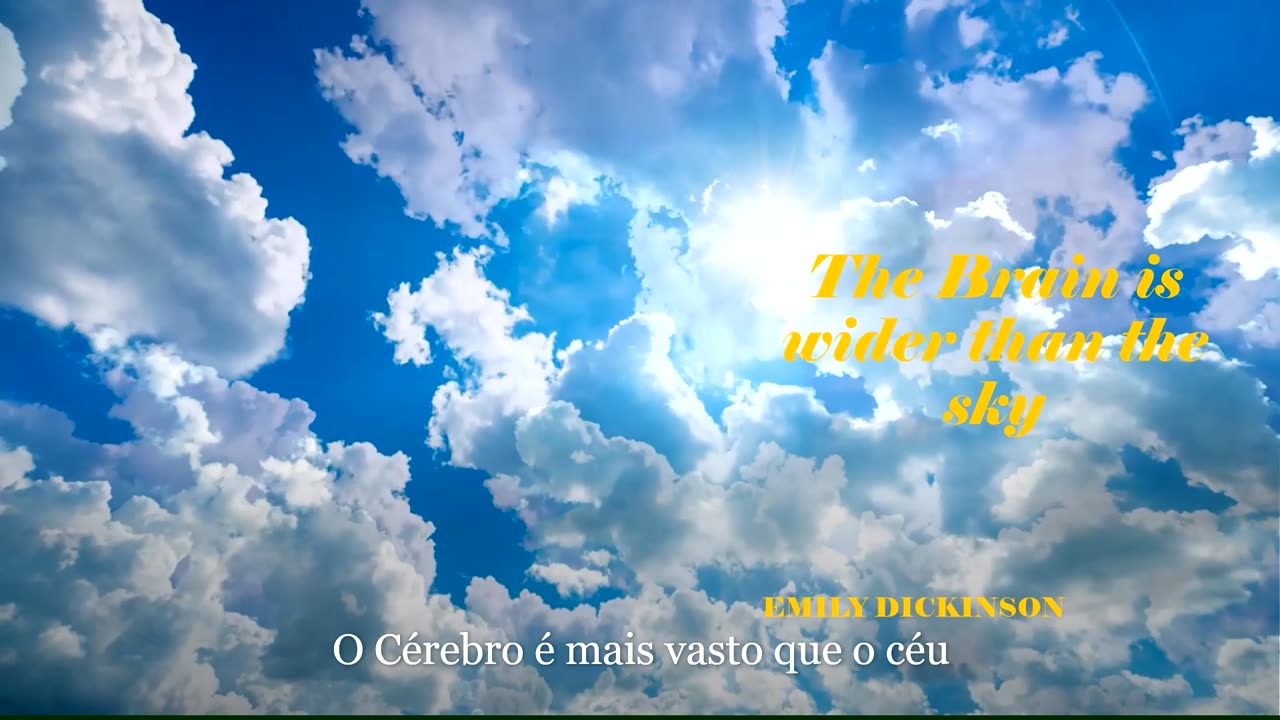Premium Only Content

Recitation of THE BRAIN IS WIDER THAN SKY by Emily Dickinson (Amherst, Massachusetts, 1830-1886)
About the author:
Emily Elizabeth Dickinson (December 10, 1830 - May 15, 1886) was an American poet. Little known during her lifetime, she was considered one of the most important figures in American poetry.[1]
Dickinson was born in Amherst, Massachusetts, into a prominent family with strong ties to its community. After studying at Amherst Academy for seven years in her youth, she briefly attended Mount Holyoke Female Seminary before returning to her family home in her hometown.
Evidence suggests that Dickinson lived out much of his clinical life. Considered an eccentric by the locals, she developed a preference for white clothing and was known for her reluctance to receive or, later in life, even to leave her room. Dickinson never married, and most friendships between her and others depend entirely on correspondence.[2]
Although Dickinson was a prolific writer, her only publications during her lifetime were 10 of her nearly 1,800 poems and a letter.[3] Poems published then were usually significantly edited to conform to conventional poetic rules. Her poems were unique in their time. They contain short lines, typically lack titles, and often use slanted rhyme as well as capital letters and unconventional punctuation.[4] Many of her poems deal with themes of death and immortality, two recur in letters to her friends, and also explore aesthetics, society, nature, and spirituality.[5] Although Dickinson's acquaintances were probably aware of her writing, it was not until her death in 1886—when Lavinia, Dickinson's younger sister, discovered her stash of poems—that her work became public. His first collection of poetry was published in 1890 by personal acquaintances Thomas Wentworth Higginson and Mabel Loomis Todd, although both heavily edited the content.
A 1998 article in The New York Times revealed that, of the many edits made to Dickinson's work, the name "Susan" was deliberately removed. At least eleven of Dickinson's poems were dedicated to sister-in-law Susan Huntington Gilbert Dickinson, although all dedications have been obliterated, presumably by Todd.[6] A complete and largely unaltered collection of her poetry first became available when scholar Thomas H. Johnson published The Poems of Emily Dickinson in 1955.
literary characteristics
Emily Dickinson, in her entire life, did not publish more than ten poems, sometimes anonymously, and had numerous works recognized only after her death. Her discreet and mysterious life challenges scholars of her work to this day. Her poetry has a unique syntactic freedom, very close to the oral use of the language, it is dense and paradoxical like her life. In her enigmatic literature, she created her own poetic idiom, despising formulas or conventional regularity.
Augusto de Campos, in the translation published in a 2008 edition by Unicamp, observes: “His poetry intersects with traces of a spiritualized pantheism, of solitude-solitude, sometimes serene, sometimes desperate, and an abysmal vision of the universe and make human. Micro and macrocosm compacted in poetic aphorisms”.[9]
Starting from trivial, everyday, domestic elements, clothing, for example, as well as small beings of nature, Dickinson brings things to life, forming respectful pictures, sometimes ministering surreal, although he expresses very clear ideas through a very plastic. Due to this caveat, many may consider it as belonging to the so-called metaphysical poetry, adding to this a certain mysticism.
(https://pt.wikipedia.org/wiki/Emily_Dickinson)
...............
Sobre a autora:
Emily Elizabeth Dickinson (Amherst, 10 de dezembro de 1830 - Amherst, 15 de maio de 1886) foi uma poetisa americana. Pouco conhecido durante sua vida, foi considerado uma das figuras mais importantes da poesia americana.[1]
Dickinson nasceu em Amherst, Massachusetts, em uma família proeminente com fortes laços com sua comunidade. Depois de estudar na Amherst Academy por sete anos em sua juventude, frequentou brevemente o Mount Holyoke Female Seminary antes de retornar para a casa de sua família em sua cidade natal.
As evidências sugerem que Dickinson viveu grande parte de sua vida clínica. Considerada uma excêntrica pelos moradores locais, desenvolveu uma preferência por roupas brancas e era conhecida por sua relutância em receber ou, mais tarde na vida, até mesmo em sair do quarto. Dickinson nunca se casou, e a maioria das amizades entre ela e outras pessoas dependem inteiramente de correspondência.[2]
Embora Dickinson fosse uma escritora prolífica, suas únicas publicações durante sua vida foram 10 de seus quase 1.800 poemas e uma carta.[3] Os poemas publicados então eram geralmente editados de forma significativa para se adequarem às regras poéticas convencionais. Seus poemas eram únicos em sua época. Eles contêm linhas curtas, normalmente não têm títulos e costumam usar rima inclinada, bem como letras maiúsculas e pontuação não convencional.[4] Muitos de seus poemas tratam de temas de morte e imortalidade, dois apresentavam recorrentes em cartas a seus amigos, e também exploram estética, sociedade, natureza e espiritualidade.[5] Embora os conhecidos de Dickinson estivessem provavelmente cientes de sua escrita, foi só depois de sua morte em 1886 - quando Lavinia, a irmã mais nova de Dickinson, descobriu seu estoque de poemas - que seu trabalho se tornou público. Sua primeira coleção de poesia foi publicada em 1890 pelos conhecidos pessoais Thomas Wentworth Higginson e Mabel Loomis Todd, embora ambos tenham editado intensamente o conteúdo.
Um artigo de 1998 no The New York Times revelou que, das muitas edições feitas no trabalho de Dickinson, o nome "Susan" foi removido deliberadamente. Pelo menos onze dos poemas de Dickinson foram dedicados à cunhada Susan Huntington Gilbert Dickinson, embora todas as dedicatórias tenham sido obliteradas, presumivelmente por Todd.[6] Uma coleção completa e quase inalterada de sua poesia tornou-se disponível pela primeira vez quando o estudioso Thomas H. Johnson publicou The Poems of Emily Dickinson em 1955.
Características literárias
Emily Dickinson, em toda sua vida, não publicou mais do que dez poemas, algumas vezes anonimamente, e teve sua numerosa obra reconhecida só após a morte. Sua vida discreta e misteriosa desafia até hoje os estudiosos de sua obra. Sua poesia possui uma liberdade sintática única, muito próxima do uso oral da língua, é densa e paradoxal como sua vida. Em sua enigmática literatura, criou um idioma poético próprio, desprezando as fórmulas ou a regularidade convencional.
Augusto de Campos, na tradução publicada em edição de 2008, pela Unicamp, observa: “Cruzam-se em sua poesia os traços de um panteísmo espiritualizado, de uma solidão-solitude, ora serena ora desesperada, e de uma visão abismal do universo e fazer ser humano. Micro e macrocosmo compactados em aforismos poéticos”.[9]
A partir de elementos triviais, cotidianos, domésticos, do vestuário, por exemplo, bem como de pequenos seres da natureza, Dickinson dá vida às coisas, formando quadros respeitosos, por vezes, ministro surreais, embora expresse idéias bastante claras através de uma linguagem muito plastic. Em razão desta ressalva, é que muitos podem considerá-la como pertencente à chamada poesia metafísica, somando-se isto a um certo misticismo.
-
 LIVE
LIVE
FreshandFit
2 hours agoFresh&Fit Meets Access Vegas!
4,130 watching -
 25:53
25:53
Stephen Gardner
5 hours ago🔥BREAKING: Trump HATING LAWYER busted in $17 million money laundering scheme!
8.82K72 -
 20:10
20:10
CartierFamily
11 hours agoAndrew Schulz DESTROYS Charlamagne’s WOKE Meltdown on DOGE & Elon Musk!
87.7K84 -
 33:56
33:56
The Why Files
9 days agoLegend of the 13 Crystal Skulls | From Mars to the Maya
40.6K37 -
 2:56:14
2:56:14
TimcastIRL
5 hours agoEPSTEIN Files DROP, FBI GOES ROGUE, AG Says They COVERED UP Epstein Case w/Amber Duke | Timcast IRL
152K69 -
 1:39:23
1:39:23
Kim Iversen
5 hours ago"Canada's Trump" Is Trudeau’s Worst Nightmare: Is Maxime Bernier the Future of Canada?
54.2K64 -
 DVR
DVR
Bannons War Room
10 days agoWarRoom Live
2.65M446 -
 16:06
16:06
The Rubin Report
12 hours agoProof the Islamist Threat in England Can No Longer Be Ignored | Winston Marshall
72.6K75 -
 2:07:07
2:07:07
Robert Gouveia
9 hours agoFBI Files Coverup! Bondi FURIOUS; SCOTUS Stops Judge; Special Counsel; FBI Does
94.7K79 -
 56:15
56:15
Candace Show Podcast
9 hours agoBREAKING: My FIRST Prison Phone Call With Harvey Weinstein | Candace Ep 153
153K109